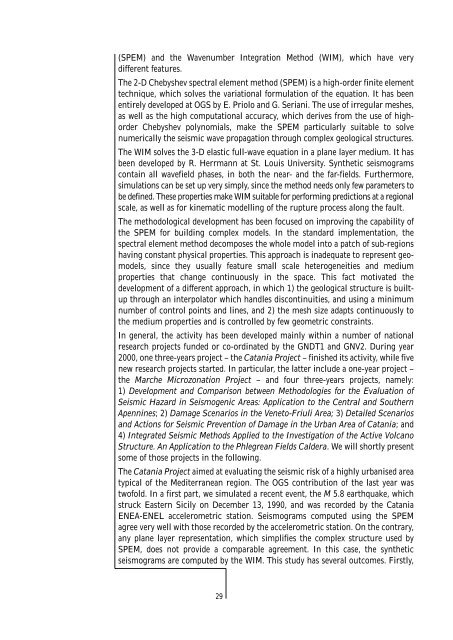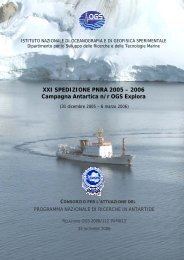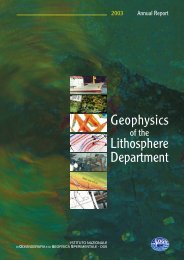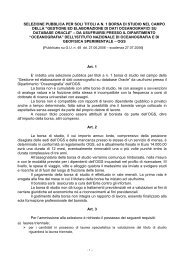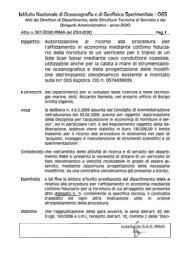Geophysical data acquisition - OGS
Geophysical data acquisition - OGS
Geophysical data acquisition - OGS
Create successful ePaper yourself
Turn your PDF publications into a flip-book with our unique Google optimized e-Paper software.
(SPEM) and the Wavenumber Integration Method (WIM), which have very<br />
different features.<br />
The 2-D Chebyshev spectral element method (SPEM) is a high-order finite element<br />
technique, which solves the variational formulation of the equation. It has been<br />
entirely developed at <strong>OGS</strong> by E. Priolo and G. Seriani. The use of irregular meshes,<br />
as well as the high computational accuracy, which derives from the use of highorder<br />
Chebyshev polynomials, make the SPEM particularly suitable to solve<br />
numerically the seismic wave propagation through complex geological structures.<br />
The WIM solves the 3-D elastic full-wave equation in a plane layer medium. It has<br />
been developed by R. Herrmann at St. Louis University. Synthetic seismograms<br />
contain all wavefield phases, in both the near- and the far-fields. Furthermore,<br />
simulations can be set up very simply, since the method needs only few parameters to<br />
be defined. These properties make WIM suitable for performing predictions at a regional<br />
scale, as well as for kinematic modelling of the rupture process along the fault.<br />
The methodological development has been focused on improving the capability of<br />
the SPEM for building complex models. In the standard implementation, the<br />
spectral element method decomposes the whole model into a patch of sub-regions<br />
having constant physical properties. This approach is inadequate to represent geomodels,<br />
since they usually feature small scale heterogeneities and medium<br />
properties that change continuously in the space. This fact motivated the<br />
development of a different approach, in which 1) the geological structure is builtup<br />
through an interpolator which handles discontinuities, and using a minimum<br />
number of control points and lines, and 2) the mesh size adapts continuously to<br />
the medium properties and is controlled by few geometric constraints.<br />
In general, the activity has been developed mainly within a number of national<br />
research projects funded or co-ordinated by the GNDT1 and GNV2. During year<br />
2000, one three-years project – the Catania Project – finished its activity, while five<br />
new research projects started. In particular, the latter include a one-year project –<br />
the Marche Microzonation Project – and four three-years projects, namely:<br />
1) Development and Comparison between Methodologies for the Evaluation of<br />
Seismic Hazard in Seismogenic Areas: Application to the Central and Southern<br />
Apennines; 2) Damage Scenarios in the Veneto-Friuli Area; 3) Detailed Scenarios<br />
and Actions for Seismic Prevention of Damage in the Urban Area of Catania; and<br />
4) Integrated Seismic Methods Applied to the Investigation of the Active Volcano<br />
Structure. An Application to the Phlegrean Fields Caldera. We will shortly present<br />
some of those projects in the following.<br />
The Catania Project aimed at evaluating the seismic risk of a highly urbanised area<br />
typical of the Mediterranean region. The <strong>OGS</strong> contribution of the last year was<br />
twofold. In a first part, we simulated a recent event, the M 5.8 earthquake, which<br />
struck Eastern Sicily on December 13, 1990, and was recorded by the Catania<br />
ENEA-ENEL accelerometric station. Seismograms computed using the SPEM<br />
agree very well with those recorded by the accelerometric station. On the contrary,<br />
any plane layer representation, which simplifies the complex structure used by<br />
SPEM, does not provide a comparable agreement. In this case, the synthetic<br />
seismograms are computed by the WIM. This study has several outcomes. Firstly,<br />
29


